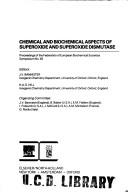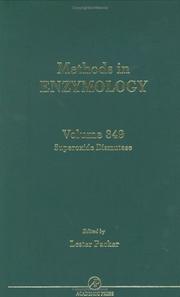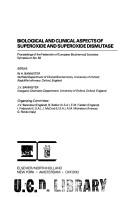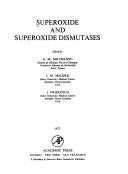| Listing 1 - 10 of 23 | << page >> |
Sort by
|

ISBN: 0444004424 Year: 1980 Publisher: New York, NY : Elsevier,
Abstract | Keywords | Export | Availability | Bookmark
 Loading...
Loading...Choose an application
- Reference Manager
- EndNote
- RefWorks (Direct export to RefWorks)
Mitochondria. --- Superoxide --- Superoxide dismutase --- Superoxide --- Superoxide dismutase

ISSN: 00766879 ISBN: 0121822524 9786611011260 1281011266 0080496970 9780121822521 Year: 2002 Volume: 349 Publisher: New York (N.Y.) Academic press
Abstract | Keywords | Export | Availability | Bookmark
 Loading...
Loading...Choose an application
- Reference Manager
- EndNote
- RefWorks (Direct export to RefWorks)
The critically acclaimed laboratory standard for more than forty years, Methods in Enzymology is one of the most highly respected publications in the field of biochemistry. Since 1955, each volume has been eagerly awaited, frequently consulted, and praised by researchers and reviewers alike. Now with more than 300 volumes (all of them still in print), the series contains much material still relevant today?truly an essential publication for researchers in all fields of life sciences.
Antineoplastic agents. --- Copper -- Physiology. --- Superoxide dismutase. --- Superoxide Dismutase --- Oxidoreductases --- Enzymes --- Enzymes and Coenzymes --- Chemicals and Drugs --- Animal Biochemistry --- Human Anatomy & Physiology --- Health & Biological Sciences --- Coenzymes and Enzymes --- Biocatalysts --- Ag-Zn Superoxide Dismutase --- Cobalt Superoxide Dismutase --- Cu-Superoxide Dismutase --- Erythrocuprein --- Fe-Superoxide Dismutase --- Fe-Zn Superoxide Dismutase --- Iron Superoxide Dismutase --- Manganese Superoxide Dismutase --- Mn-SOD --- Mn-Superoxide Dismutase --- Hemocuprein --- Ag Zn Superoxide Dismutase --- Cu Superoxide Dismutase --- Dismutase, Ag-Zn Superoxide --- Dismutase, Cobalt Superoxide --- Dismutase, Cu-Superoxide --- Dismutase, Fe-Superoxide --- Dismutase, Fe-Zn Superoxide --- Dismutase, Iron Superoxide --- Dismutase, Manganese Superoxide --- Dismutase, Mn-Superoxide --- Dismutase, Superoxide --- Fe Superoxide Dismutase --- Fe Zn Superoxide Dismutase --- Mn SOD --- Mn Superoxide Dismutase --- Superoxide Dismutase, Ag-Zn --- Superoxide Dismutase, Cobalt --- Superoxide Dismutase, Fe-Zn --- Superoxide Dismutase, Iron --- Superoxide Dismutase, Manganese --- Dehydrogenase --- Oxidase --- Reductase --- Dehydrogenases --- Oxidases --- Reductases --- Molecular Mechanisms of Pharmacological Action --- Menkes Kinky Hair Syndrome --- Superoxides --- Biocatalyst --- Enzyme --- Oxidoreductase --- Superoxide dismutase --- Enzymology.

ISBN: 0444004432 Year: 1980 Publisher: New York, NY : Amsterdam : Elsevier, Elsevier North-Holland,
Abstract | Keywords | Export | Availability | Bookmark
 Loading...
Loading...Choose an application
- Reference Manager
- EndNote
- RefWorks (Direct export to RefWorks)
SUPEROXIDE --- SUPEROXIDE DISMUTASE --- LIPIDS --- PEROXIDATION --- FREE RADICALS --- REACTIONS --- SUPEROXIDE --- SUPEROXIDE DISMUTASE --- LIPIDS --- PEROXIDATION --- FREE RADICALS --- REACTIONS

ISBN: 0124940501 9780124940505 Year: 1977 Publisher: London
Abstract | Keywords | Export | Availability | Bookmark
 Loading...
Loading...Choose an application
- Reference Manager
- EndNote
- RefWorks (Direct export to RefWorks)
Enzymology --- Human biochemistry --- Superoxide dismutase --- Superoxide --- Superoxide Dismutase --- Congresses --- congresses --- -Superoxide dismutase --- -Cerebrocuprein --- Erythrocuprein --- Hemocuprein --- Manganese enzymes --- Oxidoreductases --- Hyperoxides --- Peroxides --- Congresses. --- -Congresses --- Superoxides --- congresses. --- Cerebrocuprein --- Superoxide dismutase - Congresses --- Superoxide - Congresses
Book
ISBN: 0444874828 Year: 1989 Publisher: Amsterdam : Elsevier,
Abstract | Keywords | Export | Availability | Bookmark
 Loading...
Loading...Choose an application
- Reference Manager
- EndNote
- RefWorks (Direct export to RefWorks)
FREE RADICALS --- IRON --- RADICALS (CHEMISTRY) --- VITAMIN E --- ANTIOXIDANTS --- SUPEROXIDE DISMUTASE --- REACTIONS --- FREE RADICALS --- IRON --- RADICALS (CHEMISTRY) --- VITAMIN E --- ANTIOXIDANTS --- SUPEROXIDE DISMUTASE --- REACTIONS
Dissertation
Year: 1983 Publisher: [S. l.] : [chez l'auteur],
Abstract | Keywords | Export | Availability | Bookmark
 Loading...
Loading...Choose an application
- Reference Manager
- EndNote
- RefWorks (Direct export to RefWorks)
Superoxide dismutase --- Muscles --- Superoxyde dismutase. --- Regeneration --- Régénération (biologie) --- Régénération (biologie)
Book
Year: 1992 Publisher: München : Universitätsbuchhandlung Heinrich Frank,
Abstract | Keywords | Export | Availability | Bookmark
 Loading...
Loading...Choose an application
- Reference Manager
- EndNote
- RefWorks (Direct export to RefWorks)
Picea abies --- Picea abies --- leaves --- leaves --- Peroxidases --- Peroxidases --- Analytical methods --- Analytical methods --- pollutants --- pollutants --- Enzymes --- Enzymes --- Damage --- Damage --- air pollution --- air pollution --- Acid phosphatase --- Acid phosphatase --- Superoxide dismutase --- Superoxide dismutase --- Indicateur de pollution --- Indicateur de pollution
Book
ISBN: 0123336406 0323143261 1299460895 9780123336408 Year: 1974 Publisher: New York (N.Y.): Academic press
Abstract | Keywords | Export | Availability | Bookmark
 Loading...
Loading...Choose an application
- Reference Manager
- EndNote
- RefWorks (Direct export to RefWorks)
Enzymology --- Molecular biology --- Human biochemistry --- Oxygenases --- Oxygenases. --- Oxidoreductases --- Oxygenase --- OXYGEN --- SUPEROXIDE DISMUTASE --- CYTOCHROME-C OXIDASE --- PEROXIDASE --- OXYGENASE --- FATTY ACIDS --- CYTOCHROME OXIDASE --- BIOLOGICAL STUDIES
Book
Year: 2017 Publisher: Frontiers Media SA
Abstract | Keywords | Export | Availability | Bookmark
 Loading...
Loading...Choose an application
- Reference Manager
- EndNote
- RefWorks (Direct export to RefWorks)
Amyotrophic lateral sclerosis (ALS) is a rapidly progressive, devastating and fatal disease characterized by selective loss of upper and lower motor neurons of the cerebral cortex, brainstem, spinal cord and muscle atrophy. In spite of many years of research, the pathogenesis of ALS is still not well understood. ALS is a multifaceted genetic disease, in which genetic susceptibility to motor neuron death interacts with environmental factors and there is still no cure for this deleterious disease. At present, there is only one FDA approved drug, Riluzole which according to past studies only modestly slows the progression of the disease, and improves survival by up to three months. The suffering of the ALS patients, and their families is enormous and the economic burden is colossal. There is therefore a pressing need for new therapies. Different molecular pathways and pathological mechanisms have been implicated in ALS. According to past studies, altered calcium homeostasis, abnormal mitochondrial function, protein misfolding, axonal transport defects, excessive production of extracellular superoxide radicals, glutamate-mediated excitotoxicity, inflammatory events, and activation of oxidative stress pathways within the mitochondria and endoplasmic reticulum can act as major contributor that eventually leads to loss of connection between muscle and nerve ultimately resulting to ALS. However, the detailed molecular and cellular pathophysiological mechanisms and origin and temporal progression of the disease still remained elusive. Ongoing research and future advances will likely advance our improve understanding about various involved pathological mechanism ultimately leading to discoveries of new therapeutic cures. Importantly, clinical biomarkers of disease onset and progression are thus also urgently needed to support the development of the new therapeutic agents and novel preventive and curative strategies. Effective translation from pre-clinical to clinical studies will further require extensive knowledge regarding drug activity, bioavailability and efficacy in both the pre-clinical and clinical setting, and proof of biological activity in the target tissue. During the last decades, the development of new therapeutic molecules, advance neuroimaging tools, patient derived induced stem cells and new precision medicine approaches to study ALS has significantly improved our understanding of disease. In particular, new genetic tools, neuroimaging methods, cellular probes, biomarker study and molecular techniques that achieve high spatiotemporal resolution have revealed new details about the disease onset and its progression. In our effort to provide the interested reader, clinician and researchers a comprehensive summaries and new findings in this field of ALS research, hereby we have created this electronic book which comprises of twenty seven chapters having various reviews, perspective and original research articles. All these chapters and articles in this book not only summarize the cutting-edge techniques, approaches, cell and animal models to study ALS but also provide unprecedented coverage of the current developments and new hypothesis emerging in ALS research. Some examples are novel genetic and cell culture based models, mitochondria-mediated therapy, oxidative stress and ROS mechanism, development of stem cells and mechanism-based therapies as well as novel biomarkers for designing and testing effective therapeutic strategies that can benefit ALS patients who are at the earlier stages in the disease. I am extremely grateful to all the contributors to this book and want to thank them for their phenomenal efforts. Amyotrophic lateral sclerosis (ALS) is a rapidly progressive, devastating and fatal disease characterized by selective loss of upper and lower motor neurons of the cerebral cortex, brainstem, spinal cord and muscle atrophy. In spite of many years of research, the pathogenesis of ALS is still not well understood. ALS is a multifaceted genetic disease, in which genetic susceptibility to motor neuron death interacts with environmental factors and there is still no cure for this deleterious disease. At present, there is only one FDA approved drug, Riluzole which according to past studies only modestly slows the progression of the disease, and improves survival by up to three months. The suffering of the ALS patients, and their families is enormous and the economic burden is colossal. There is therefore a pressing need for new therapies. Different molecular pathways and pathological mechanisms have been implicated in ALS. According to past studies, altered calcium homeostasis, abnormal mitochondrial function, protein misfolding, axonal transport defects, excessive production of extracellular superoxide radicals, glutamate-mediated excitotoxicity, inflammatory events, and activation of oxidative stress pathways within the mitochondria and endoplasmic reticulum can act as major contributor that eventually leads to loss of connection between muscle and nerve ultimately resulting to ALS. However, the detailed molecular and cellular pathophysiological mechanisms and origin and temporal progression of the disease still remained elusive. Ongoing research and future advances will likely advance our improve understanding about various involved pathological mechanism ultimately leading to discoveries of new therapeutic cures. Importantly, clinical biomarkers of disease onset and progression are thus also urgently needed to support the development of the new therapeutic agents and novel preventive and curative strategies. Effective translation from pre-clinical to clinical studies will further require extensive knowledge regarding drug activity, bioavailability and efficacy in both the pre-clinical and clinical setting, and proof of biological activity in the target tissue. During the last decades, the development of new therapeutic molecules, advance neuroimaging tools, patient derived induced stem cells and new precision medicine approaches to study ALS has significantly improved our understanding of disease. In particular, new genetic tools, neuroimaging methods, cellular probes, biomarker study and molecular techniques that achieve high spatiotemporal resolution have revealed new details about the disease onset and its progression. In our effort to provide the interested reader, clinician and researchers a comprehensive summaries and new findings in this field of ALS research, hereby we have created this electronic book which comprises of twenty seven chapters having various reviews, perspective and original research articles. All these chapters and articles in this book not only summarize the cutting-edge techniques, approaches, cell and animal models to study ALS but also provide unprecedented coverage of the current developments and new hypothesis emerging in ALS research. Some examples are novel genetic and cell culture based models, mitochondria-mediated therapy, oxidative stress and ROS mechanism, development of stem cells and mechanism-based therapies as well as novel biomarkers for designing and testing effective therapeutic strategies that can benefit ALS patients who are at the earlier stages in the disease. I am extremely grateful to all the contributors to this book and want to thank them for their phenomenal efforts.
Mitochondria --- neurodegenerative disease --- Ca2+ signaling --- multidrug therapy --- Amyotrophic lateral sclerosis (ALS) --- Superoxide dismutase 1 (SOD1) --- Motor neuron disease (MND) --- excitotoxicity --- Riluzole --- multifactorial disease --- Mitochondria --- neurodegenerative disease --- Ca2+ signaling --- multidrug therapy --- Amyotrophic lateral sclerosis (ALS) --- Superoxide dismutase 1 (SOD1) --- Motor neuron disease (MND) --- excitotoxicity --- Riluzole --- multifactorial disease
Book
Year: 2021 Publisher: Basel, Switzerland MDPI - Multidisciplinary Digital Publishing Institute
Abstract | Keywords | Export | Availability | Bookmark
 Loading...
Loading...Choose an application
- Reference Manager
- EndNote
- RefWorks (Direct export to RefWorks)
This Special Issue aims to provide new insights into the issue of the mercury contamination of terrestrial and aquatic ecosystems. This ubiquitous contaminant has been used by humans for many years, resulting in global contamination. When this toxic contaminant is converted to methylmercury, it accumulates in trophic chains, which is a major issue for wildlife and human health. The nine articles contained within this Special Issue on ‘‘Mercury and Methylmercury Contamination of Terrestrial and Aquatic Ecosystems’’ endeavour to identify the historical evolution of Hg and MeHg levels in aquatic environments, and to evaluate the impact of current and historical human activities, such as mining, climate change, and soil erosion, on receptor ecosystems and food chains.
Research & information: general --- Chemistry --- Cytotoxicity --- erythrocytes --- methylmercury --- malondialdehyde --- in vitro --- superoxide dismutase --- mercury --- PQMI --- Palawan --- abandoned mines --- mine wastes --- sediments --- mussel --- mussel watch --- Mytilus --- St. Lawrence --- sediment --- water --- SPM --- gold mining --- French Guiana --- monomethylmercury --- water-sediment interface --- diel and seasonal cycles --- photodegradation --- particulate mercury --- suspended particulate matter --- particulate organic carbon --- Amazon rainforest --- mammoth fauna mammals --- hair --- environmental changes --- paleoclimate --- Pleistocene --- Yakutia --- lakes --- wet deposition --- ecological restoration --- mercury mobility --- microbial activities --- biogeochemistry --- gold mining activities --- Cytotoxicity --- erythrocytes --- methylmercury --- malondialdehyde --- in vitro --- superoxide dismutase --- mercury --- PQMI --- Palawan --- abandoned mines --- mine wastes --- sediments --- mussel --- mussel watch --- Mytilus --- St. Lawrence --- sediment --- water --- SPM --- gold mining --- French Guiana --- monomethylmercury --- water-sediment interface --- diel and seasonal cycles --- photodegradation --- particulate mercury --- suspended particulate matter --- particulate organic carbon --- Amazon rainforest --- mammoth fauna mammals --- hair --- environmental changes --- paleoclimate --- Pleistocene --- Yakutia --- lakes --- wet deposition --- ecological restoration --- mercury mobility --- microbial activities --- biogeochemistry --- gold mining activities
| Listing 1 - 10 of 23 | << page >> |
Sort by
|

 Search
Search Feedback
Feedback About UniCat
About UniCat  Help
Help News
News